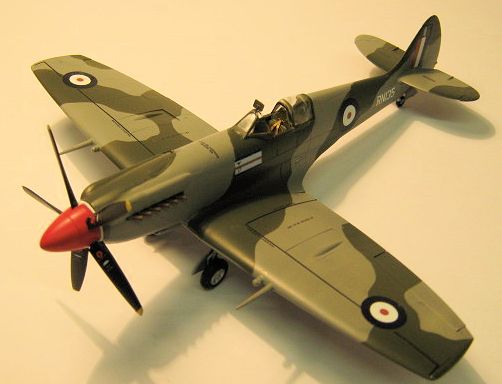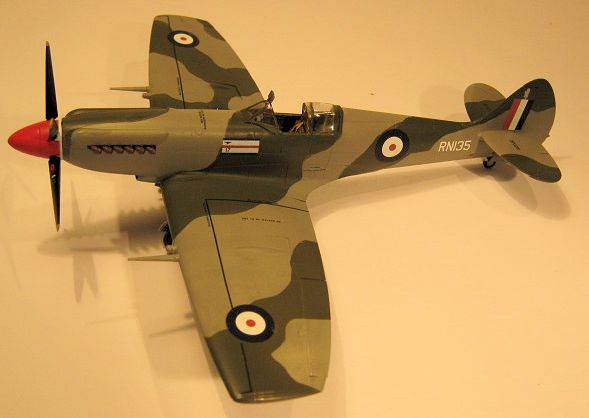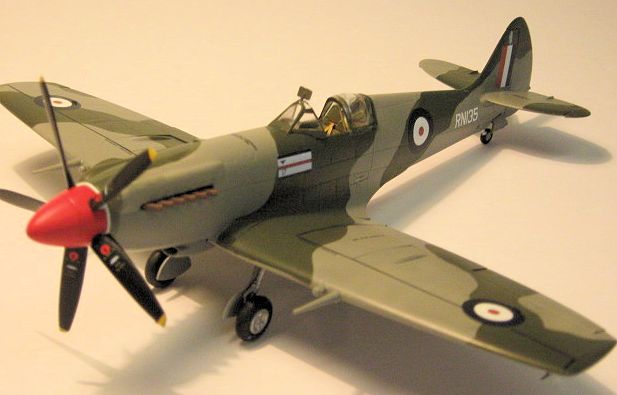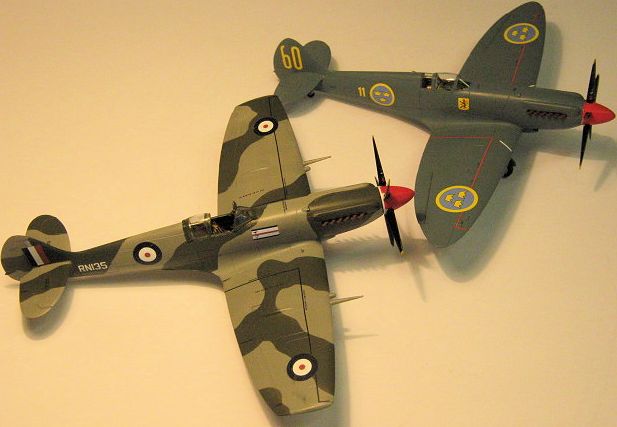Airfix/ICM 1/48 Spitfire XIVe
|
KIT #: |
|
|
PRICE: |
$£36-00
in total |
|
DECALS: |
Several options |
|
REVIEWER: |
Frank Reynolds |
|
NOTES: |
Freightdog
decals
used |

Technology often advances at a great rate during times of conflict.
In the world of fighter aircraft, more speed and more altitude are in
constant demand to gain the edge over potential opponents. The Merlin engined
Spitfire was a point defence interceptor of ideal specification for the early
years of World War 2 with
 a 1,600 horse power engine and a speed of around 370
mph. The definitive Merlin Spitfire was the Mk.VIII/IX series, development of
which peaked in 1943. Supermarine introduced the Griffon engined Mk XII in 1943,
an emergency conversion of the
Mk.V,
but only 100 were built. A definitive redesign of the Mk.VIII, powered by a
2,000 hp engine first entered service in early 1944 as the Mk XIV. The Griffon
engine was a fine example of progressive technology, for although it was barely
larger than the legendary Merlin it was 36% larger in swept volume,at 2,239
cu.in and in its matured form, drove a much larger 5-bladed propeller. This was
a wholly new style of Spitfire, heavier and more rugged, competitive with later
generations of the Focke Wulf 190s, approaching par with the P-47 and P-51 and
much better suited to the territory – hopping campaign of war in Europe after
the D day invasion. The XIV would see post war service in RAF Germany and the
Far East and become part of the inventory of the Air Forces of Belgium, India
and Thailand.
a 1,600 horse power engine and a speed of around 370
mph. The definitive Merlin Spitfire was the Mk.VIII/IX series, development of
which peaked in 1943. Supermarine introduced the Griffon engined Mk XII in 1943,
an emergency conversion of the
Mk.V,
but only 100 were built. A definitive redesign of the Mk.VIII, powered by a
2,000 hp engine first entered service in early 1944 as the Mk XIV. The Griffon
engine was a fine example of progressive technology, for although it was barely
larger than the legendary Merlin it was 36% larger in swept volume,at 2,239
cu.in and in its matured form, drove a much larger 5-bladed propeller. This was
a wholly new style of Spitfire, heavier and more rugged, competitive with later
generations of the Focke Wulf 190s, approaching par with the P-47 and P-51 and
much better suited to the territory – hopping campaign of war in Europe after
the D day invasion. The XIV would see post war service in RAF Germany and the
Far East and become part of the inventory of the Air Forces of Belgium, India
and Thailand.
This is just one more step on the road of my never-ending project of
modelling the Spitfire series in 1: 48 scale. After five years and around 60
kits into it, I now find that I am scrapping and replacing some of my earlier
efforts as my finishing techniques change or when newer and better kits come
onto the market.
One variant that has consistently proved a challenge is the Mk.XIV and
its close cousin the Mk.XVIII. The XIV was produced in two main versions, the
earlier having the original-style Spitfire high back fuselage and a later
version with a cut down rear fuselage and bubble canopy.
The only current mainstream kits of a Spitfire XIV in 1:48 scale comes
from Academy, neatly tooled, but rather poorly executed in that the nose area is
too bloated and it does not capture the deadly beauty of the subject.
With the recent release by Airfix of their Spitfire PR.19, the full size of
which is effectively an unarmed Mk.XIV, this should be a good basis of a more
accurate high back Mk.XIV fighter. In this exercise the cannon armed wing that
is required comes from ICM’s Spitfire Mk.IX- a kit of good provenance that has
the advantage of being very reasonably priced – around £9-99 at some outlets –
and even if you only use the wing
and
windscreen the remaining parts yield a mighty harvest for the spares box. A dry
fit of the chosen fuselage and wing assemblies looked promising and gave me
enough confidence to proceed.
 The fuselage of the Airfix kit needs to be stripped of the essential
characteristics of the PR version – the unarmoured, rounded one-piece
windscreen, the intake on the lower cowl side, under the exhausts, for the cabin
pressurisation system and filling the camera ports in the fuselage sides. The
drop down cockpit access flap on the port side should be scribed in since this
feature was omitted from the pressurised Mk.19.The resultant holes in the cowl
side, the aperture for the fuselage camera and some minor sink holes under the
edge of the cockpit were filled with Green Putty
The fuselage of the Airfix kit needs to be stripped of the essential
characteristics of the PR version – the unarmoured, rounded one-piece
windscreen, the intake on the lower cowl side, under the exhausts, for the cabin
pressurisation system and filling the camera ports in the fuselage sides. The
drop down cockpit access flap on the port side should be scribed in since this
feature was omitted from the pressurised Mk.19.The resultant holes in the cowl
side, the aperture for the fuselage camera and some minor sink holes under the
edge of the cockpit were filled with Green Putty
The PR.19 kit has the option to model the canopy open, using a part first
introduced on Airfix’s Spitfire Mk.12 fighter, where the fixed rear section and
sliding centre section of the canopy are combined into a one-piece unit,
although this is very thick and requires some awkward masking inside and out and
a small section of the fuselage has to be cut away to accommodate it. I had
avoided using it in my previous build of both the Mk.XII and the PR.19, so it
was time to experiment. Having an open cockpit was also a useful potential cheat
since it would avoid any worries about lining up the ICM armoured windscreen
against the Airfix cockpit hood and rear section.
I first built the wing from the ICM parts, consisting of the one
piece full span lower section, left and right upper wing panels and clipped wing
tips. ICM provide inserts for the correct cannon bay covers for the “e” wing
armament where the cannon occupy the outer of the two wing stubs and the inners
are blanked off with two small hemispherical plugs. A further advantage of the
ICM kit in this context is the useful alternative parts for the wing tips and
ailerons which include the smaller inset ailerons applicable to the Mk.XIV and
matching clipped wing tips.
The
small infill sections from the ICM carburettor intake were cut away and fixed
into the gap in the front centre part of the lower wing.
For
the fuselage, I followed the sequence set out in the Airfix instructions.
Commencing with the cockpit interior, the fuselage was assembled and allowed to
set hard over a couple of days. When building the interior I used the ICM
instrument panel and gun sight and omitted the redundant bulkheads and equipment
from the camera bay. Seat belts from an Eduard PE set were used to detail the
seat.
 Once everything had set over a couple of days the wing was offered up to
the fuselage halves to check where any fiddling and fettling was required. The
upper wing joint was pretty good; the lower section required some carving around
the sweeping joint of the wing fairings to the rear of the trailing edge. The
only dramatic mismatch of parts was a large gap where the cameras would have
been on the Mk.19. This could be filled in with scrap plastic and filler – I
chose to use an offcut from a spare wing sourced my ever-growing Spitfire spares
box, adjusted with a sliver of plastic card and some careful sanding and
carving. The Airfix lower nose section and carb air intake could be added
unmodified.
The
tail assembly was all from unmodified Airfix components.
The Airfix under wing radiators were blended into the ICM wing, requiring a
little fettling along the flanges at the base of the side walls that fair into
the wing lower surfaces.
Once everything had set over a couple of days the wing was offered up to
the fuselage halves to check where any fiddling and fettling was required. The
upper wing joint was pretty good; the lower section required some carving around
the sweeping joint of the wing fairings to the rear of the trailing edge. The
only dramatic mismatch of parts was a large gap where the cameras would have
been on the Mk.19. This could be filled in with scrap plastic and filler – I
chose to use an offcut from a spare wing sourced my ever-growing Spitfire spares
box, adjusted with a sliver of plastic card and some careful sanding and
carving. The Airfix lower nose section and carb air intake could be added
unmodified.
The
tail assembly was all from unmodified Airfix components.
The Airfix under wing radiators were blended into the ICM wing, requiring a
little fettling along the flanges at the base of the side walls that fair into
the wing lower surfaces.
The undercarriage came from the Airfix parts, using the standard main wheels
rather than the alternatives that have flats moulded onto the tyres, purely a
personal preference. The main undercarriage legs have a new detail, where the
outer face of the leg is moulded flat so that the inner face of the bay door has
a positive location. The retractable tail wheel assembly is easy to install
since Airfix have moulded interlocking base plates that ensure that the doors
are correctly aligned – a small point but one that will be appreciated by anyone
who has tried to fiddle tiny Spitfire tail wheel doors into alignment on kits
that do not have such a feature.
The armoured windscreen and rear view mirror were taken directly from the ICM
kit and fitted neatly onto the Airfix underpinnings.
Fortunately, Freightdog in the UK produce the exact decals that I needed,
the subject being “Brits Abroad, the Immediate Post War RAF”, (ref FSD48-001S),
an excellent sheet that includes a
choice of two high back XIVs of No 17 Squadron, part of the Air Component,
British Commonwealth Occupation Force at Miho, Japan, in 1946, where they served
until the squadron disbanded in
February 1948. They feature the less common combination of a high back and
clipped wings. They are both in an unusual colour scheme of Medium Sea Grey
under surfaces with upper surfaces of Dark Green and Medium Sea Grey – a scheme
that is more often associated with RAF night fighters. They also have a rather
strangely proportioned immediate post-war style of red/white/blue national
markings, featuring a small red dot in the centre of the roundel.
This colour scheme looks, frankly, weird, almost reminiscent of the
well-meaning but inaccurate colour schemes that could be found decorating some
RAF station gate guards during the 1950s and 60s. This would an unusual
combination of features for the collection.
 This decal sheet is well worth buying so as to bank the unused subjects for
future projects since the sheet also includes markings for a temperate schemed
Mk.XVIII of the RAF’s No32 Sqn. in Palestine, 1948, a temperate schemed low back
Mk.XIVe
of 11 Sqn., Japan 1948 and
a SEAC –style schemed low back
XIVe of
No 28 Sqn, Kuala Lumpur 1948. (There are also three options for P-47s – a matter
of passing interest since I understand that the RAF may have operated some
aircraft other than the Spitfire at some time!) The decal sheet includes full
national markings, codes, serials and badges for each option but airframe
stencilling and wing walks must be found elsewhere, in my case from Airfix
Spitfire XII sheets, although the propeller stencils came from the PR.19 sheet.
The wing walk lines need to be longer than those found on most Spitfire paint
finishes since the wing roundels are of an unusually small size. I chose the
option for No 17 Sqn’s commander, Battle of Britain hero “Ginger” Lacey since it
featured the prominent Squadron Leader’s pennant on the fuselage sides forward
of the cockpit.
This decal sheet is well worth buying so as to bank the unused subjects for
future projects since the sheet also includes markings for a temperate schemed
Mk.XVIII of the RAF’s No32 Sqn. in Palestine, 1948, a temperate schemed low back
Mk.XIVe
of 11 Sqn., Japan 1948 and
a SEAC –style schemed low back
XIVe of
No 28 Sqn, Kuala Lumpur 1948. (There are also three options for P-47s – a matter
of passing interest since I understand that the RAF may have operated some
aircraft other than the Spitfire at some time!) The decal sheet includes full
national markings, codes, serials and badges for each option but airframe
stencilling and wing walks must be found elsewhere, in my case from Airfix
Spitfire XII sheets, although the propeller stencils came from the PR.19 sheet.
The wing walk lines need to be longer than those found on most Spitfire paint
finishes since the wing roundels are of an unusually small size. I chose the
option for No 17 Sqn’s commander, Battle of Britain hero “Ginger” Lacey since it
featured the prominent Squadron Leader’s pennant on the fuselage sides forward
of the cockpit.
Hannants’ Xtracrylix paints provided the camouflage scheme, applied with my long
serving Iwata HP-C airbrush This finish is a little simpler than most
camouflaged Spitfires, requiring an overall coat of Sea Grey Medium and then the
upper surfaces shadow shaded in Dark
Green. The propeller spinner was an easy exercise since the forward cone is red
and the back plate, separately moulded by Airfix, is white, so the two
components can be painted prior to assembly.
The decals went on well over a coat of Future/Kleer and responded effectively to
Micro Set and Micro Sol.
I have previously tried a similar
cross-kitting exercise to produce a Seafire XV from a Spitfire XII and a Seafire
XVII. The Mk XIV project was a little more complicated since a certain amount of
filling and scribing is necessary and careful work to blend in the rear lower
section of the wing to the fuselage. I am reasonably satisfied with the result
and the cost is not too bad compared
with the amount of money that is charged for some short-run kits and I found the
decals to be excellent. As to the gimmick of the open canopy option from the
rather thick Airfix component - I am not totally convinced. It is not bad enough
to warrant my tearing it off and replacing it, but I am unlikely to use it on
another model.
Overall, I think that the exercise works, although for some weird reason this
project left me feeling vaguely dis-satisfied and I cannot quite say why. It may
be the slightly strange canopy arrangement; it may be the
 unusual camouflage
scheme that, although correct for the period, puts me so much in mind of
incorrectly finished gate guards of the 1960s. It may be the fact that my
usually reliable Iwata HP-C airbrush was playing up and needed constant cleaning
during the painting process. When in doubt, assume that it was operator error -
perhaps it was just an off day.
Yet, this is another tick in the box for the Spitfire and Seafire
collection.
unusual camouflage
scheme that, although correct for the period, puts me so much in mind of
incorrectly finished gate guards of the 1960s. It may be the fact that my
usually reliable Iwata HP-C airbrush was playing up and needed constant cleaning
during the painting process. When in doubt, assume that it was operator error -
perhaps it was just an off day.
Yet, this is another tick in the box for the Spitfire and Seafire
collection.
On that note, I set up the XIVe for a photo shoot alongside Airfix’s
standard PR.19, just to prove that all Spitfires look the same, except where
they differ.
Compared with the PR Mk.19, the most obvious features of this XIVe are:
An armoured windscreen.
Clipped wing tips.
A wing featuring fairings and barrels for the cannon.
Yet minimal changes in outline and a different colour scheme give a
noticeably different look – all the reasons that the Spitfire series is such a
fascinating modelling subject.
I now have an unused PR wing
and windscreen– so maybe a PR.IX beckons, who knows?
Spitfire International by Helmut Terbeck, Harry van der Meer and Ray
Sturtivant, Air Britain (Historians) Ltd 2002.
Spitfire, the History by Eric B. Morgan and Edward Shacklady, Key Publishing,
2000
Aircraft Profile No 246, Supermarine Spitfire (Griffons) Mks. XIV and
XVIII by L.J. Bachelor. Profile Publications Ltd., 1972.
Frank Reynolds
April 2013
If you would like your product reviewed fairly and fairly quickly, please
contact
the editor or see other details in the
Note to
Contributors.
Back to the Main Page
Back to the Review
Index Page


 a 1,600 horse power engine and a speed of around 370
mph. The definitive Merlin Spitfire was the Mk.VIII/IX series, development of
which peaked in 1943. Supermarine introduced the Griffon engined Mk XII in 1943,
an emergency conversion of the
Mk.V,
but only 100 were built. A definitive redesign of the Mk.VIII, powered by a
2,000 hp engine first entered service in early 1944 as the Mk XIV. The Griffon
engine was a fine example of progressive technology, for although it was barely
larger than the legendary Merlin it was 36% larger in swept volume,at 2,239
cu.in and in its matured form, drove a much larger 5-bladed propeller. This was
a wholly new style of Spitfire, heavier and more rugged, competitive with later
generations of the Focke Wulf 190s, approaching par with the P-47 and P-51 and
much better suited to the territory – hopping campaign of war in Europe after
the D day invasion. The XIV would see post war service in RAF Germany and the
Far East and become part of the inventory of the Air Forces of Belgium, India
and Thailand.
a 1,600 horse power engine and a speed of around 370
mph. The definitive Merlin Spitfire was the Mk.VIII/IX series, development of
which peaked in 1943. Supermarine introduced the Griffon engined Mk XII in 1943,
an emergency conversion of the
Mk.V,
but only 100 were built. A definitive redesign of the Mk.VIII, powered by a
2,000 hp engine first entered service in early 1944 as the Mk XIV. The Griffon
engine was a fine example of progressive technology, for although it was barely
larger than the legendary Merlin it was 36% larger in swept volume,at 2,239
cu.in and in its matured form, drove a much larger 5-bladed propeller. This was
a wholly new style of Spitfire, heavier and more rugged, competitive with later
generations of the Focke Wulf 190s, approaching par with the P-47 and P-51 and
much better suited to the territory – hopping campaign of war in Europe after
the D day invasion. The XIV would see post war service in RAF Germany and the
Far East and become part of the inventory of the Air Forces of Belgium, India
and Thailand.

 This decal sheet is well worth buying so as to bank the unused subjects for
future projects since the sheet also includes markings for a temperate schemed
Mk.XVIII of the RAF’s No32 Sqn. in Palestine, 1948, a temperate schemed low back
Mk.XIVe
of 11 Sqn., Japan 1948 and
a SEAC –style schemed low back
XIVe of
No 28 Sqn, Kuala Lumpur 1948. (There are also three options for P-47s – a matter
of passing interest since I understand that the RAF may have operated some
aircraft other than the Spitfire at some time!) The decal sheet includes full
national markings, codes, serials and badges for each option but airframe
stencilling and wing walks must be found elsewhere, in my case from Airfix
Spitfire XII sheets, although the propeller stencils came from the PR.19 sheet.
The wing walk lines need to be longer than those found on most Spitfire paint
finishes since the wing roundels are of an unusually small size. I chose the
option for No 17 Sqn’s commander, Battle of Britain hero “Ginger” Lacey since it
featured the prominent Squadron Leader’s pennant on the fuselage sides forward
of the cockpit.
This decal sheet is well worth buying so as to bank the unused subjects for
future projects since the sheet also includes markings for a temperate schemed
Mk.XVIII of the RAF’s No32 Sqn. in Palestine, 1948, a temperate schemed low back
Mk.XIVe
of 11 Sqn., Japan 1948 and
a SEAC –style schemed low back
XIVe of
No 28 Sqn, Kuala Lumpur 1948. (There are also three options for P-47s – a matter
of passing interest since I understand that the RAF may have operated some
aircraft other than the Spitfire at some time!) The decal sheet includes full
national markings, codes, serials and badges for each option but airframe
stencilling and wing walks must be found elsewhere, in my case from Airfix
Spitfire XII sheets, although the propeller stencils came from the PR.19 sheet.
The wing walk lines need to be longer than those found on most Spitfire paint
finishes since the wing roundels are of an unusually small size. I chose the
option for No 17 Sqn’s commander, Battle of Britain hero “Ginger” Lacey since it
featured the prominent Squadron Leader’s pennant on the fuselage sides forward
of the cockpit. unusual camouflage
scheme that, although correct for the period, puts me so much in mind of
incorrectly finished gate guards of the 1960s. It may be the fact that my
usually reliable Iwata HP-C airbrush was playing up and needed constant cleaning
during the painting process. When in doubt, assume that it was operator error -
perhaps it was just an off day.
unusual camouflage
scheme that, although correct for the period, puts me so much in mind of
incorrectly finished gate guards of the 1960s. It may be the fact that my
usually reliable Iwata HP-C airbrush was playing up and needed constant cleaning
during the painting process. When in doubt, assume that it was operator error -
perhaps it was just an off day.